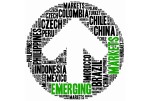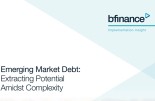Aegon AM: Opportunities for Emerging Market Debt in 2024
Aegon AM: Opportunities for Emerging Market Debt in 2024

Emerging markets have a favourable backdrop to start 2024, which should provide the opportunity for another year of positive returns following a successful 2023 for EMD.
Robust growth, disinflation, and monetary easing trends are gaining momentum across most emerging economies, establishing a solid foundation for EMD performance in the upcoming year. This is further reinforced by the Federal Reserve's pivot in December to end their hiking cycle which should support growth through policy easing later in 2024, especially as US inflation shows signs of moderation.
However, a considerable portion of this optimistic shift is already reflected in EM bond pricing, particularly in sovereigns where credit spreads of investment-grade bonds are trading near decade lows. Despite these positive indicators, some caution is warranted. The upward revisions to global growth forecasts are primarily driven by US exceptionalism rather than broader synchronization.
If this trend persists over an extended period, it could eventually exert pressure on emerging market currencies, prompting policymakers to slow down their easing cycles and thereby impeding growth. It is important to note that we do not anticipate a significant tightening of the headline credit spread for the asset class from its current levels. Nevertheless, within the asset class, ample opportunities exist for investors to align with a more optimistic outlook and potentially achieve higher returns.
We favour high yield corporate bonds of emerging markets in the current environment. Particularly fundamentally robust BB-rated corporates which have lagged the spread tightening of their sovereign counterparts since early 2023. Brazil and Colombia offer the best opportunities within Latin America and Turkey has issued many interesting opportunities in the past six months.
There are also attractive opportunities in resilient telecommunications and related infrastructure in frontier jurisdictions. These are exhibiting favourable market trends in marked contrast to the saturated telecoms markets of the Americas and Europe. Whilst much of the financials widening stemming from the US regional bank woes of early 2023 has retraced, there remains some premium in the debut issuances from Eastern European banks.
Lastly, Turkish corporate bonds look compelling relative to sovereign bonds having historically traded tighter to reflect a combination of dollarized export earnings, offshore liquidity and foreign sponsors, which provide some shelter to any return of politically induced volatility there. Ukrainian corporates have been another favoured sector, though bond prices are now reflecting their remarkable capacity to adapt to the shifting operating environment.
Within sovereigns, opportunities are more idiosyncratic. The underperformance of BBB-rated sovereigns relative to US credit since mid-2023, exacerbated by last month’s heavy supply, has provided better entry levels for Romania through primary markets. Ivory Coast is one of the few fundamentally positive stories on the African continent at this juncture, having broken the two-year bond issuance hiatus for SSA sovereign issuers.
Most value resides in CCC-rated and restructuring sovereigns, despite last year’s very high returns. As the IMF and bilateral lenders have stepped in, fears of a sharp wave of sovereign defaults following the successive economic shocks from 2020-22 have calmed. A few stressed issuers, such as Pakistan, are now likely to remain current into at least 2025 which should offer further upside. Lastly, those concluding their debt restructurings such as Ghana will likely be conducive for investor returns.









